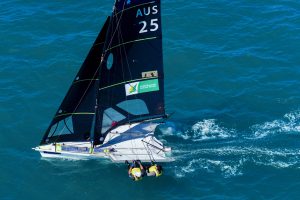Each year the world sailing scene assembles in Miami to race in one of the best off season locations in the world. Over the past 2 Olympic cycles the Miami Olympic Classes regatta has come into it’s own, with excellent particiapation from around the globe. This has been especially true for the 49er class, which has seen many European teams spend extended periods in North America over their winter. With the 2016 Olympics in South America, it is still up in the air as to what role Miami will play in this quad, but it is likely to be seen as a complement to South American events and see it’s role expanded once again.
The 49er fleet is in for a special year in 2013 with the 49erFX joining the Olympic scene. The class decided to place the North American Championships in Miami back to back with the Miami world cup to bolster both events. The class is also using both events to test format options using Theatre Style racing to conclude both events. So far, all Theatre Style Racing has been using low point scoring, and that is still the leading contender. There are other scoring options that are being considered, and the class is using the 2013 regattas as a chance to test all of the options available.

First off is the 2013 North American’s, Jan 18-20, and fleets of 20 and 10 boats are expected for the 49er and 49erFX respectively. A shortage of charter boats has held back the numbers somewhat this year as many national teams balked at shipping full containers in this year after the games.
Another focus for the class is how to film the pre-start. Our coverage to date, and even the America’s Cup coverage, has been able to show the excitement of racing, but has not captured the intensity of the start. One focus area for the media team at this event will be the pre-start manouvering, so lets see what can be done.
The North American’s will be using the ‘First to 10’ format option which is one of the 4 leading options for concluding regattas as determined by the format committee of the 49er class. The basics of the format are as follows. The top 8 teams go into the finals. The first place team enters carrying 5 points already, 2nd carries 4 points, etc. and 5th carries 1 point. 6-8 start with 0 points.
In each Theatre Style race, the winner gets four points, second place gets three points, 3rd place gets two points, and 4th gets one point. The first team to score 10 points or more, wins the event. The event continues until second and third overall can secure 10 points also, creating a podium all having achieved 10 points. In a field of 8 boats it is likely that the winner will be crowned after 2-4 races, and the silver and bronze medals decided between 3-6 races. At roughly 8 minutes per race, it should make for a nice event.
The positives of this format are that the winner of the event will have sailed well in the final race, top 4 by definition. There are also numerous and complex battles that can take place during the racing as teams must manage their scores and also try to influence other teams performances along the way.
The negatives are that the focus become more on winning races than sailing consistently. Also, it’s considered by some too complicated to ask sailors and fans to focus on the battles within the races as well as the races themselves.
We’ll see, and hopefully so will all of you. While we will not have a professional camera crew to film the event like we did at the 2012 Seiko European Championships, we will have 2 film boats and go pros on as many boats as possible. We’ll stitch it all together so that sailing fans can decide for themselves on the quality of the format and Theatre Style in general.
The Miami World Cup, or MOCR, will also finish using Theatre Style racing for the 49er and 49erFX also. For MOCR, the ‘Big Sixy’ format will be trialled. This is a very simple format to explain.

The top 6 teams get to go to the finals. The team leading the event carries with them 1 race win. The first team of the six to win 2 races, wins the regatta. The remaining places are determined by a low point scoring system of the finals.
The main benefits of this system are the simplicity. It’s easy to explain, and even easier to understand for the viewing public. Also, the winner of the event is the team that wins the last race of the event. Sailing is one of the most wide open sports in terms of who can win medals. While there are some within the large sailing federations who want to continually reduce the chance factor of who wins, competitive balance is a great achivement for sailing.
The main drawbacks of the system is that it all comes down to a single day, and winning races is put at a huge premium. Although teams do need to work hard during the regatta leading up to the final, places 2-5 enter the final tied essentially, with the leader carrying in a crucial win. Unfortunately for spectators, watching a teams sailing with the lead is not always the most exciting aspect of fleet racing, which is why this is listed as a drawback.
Again, we will not have a professional film crew to document the racing, but we will do our best to bring you the action as we can.






